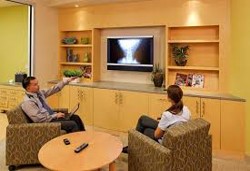Among my varied adventures as an undergraduate student at Virginia tech was my time spent working in a small pizza restaurant. In the role, I was often assigned to come in before the restaurant opened and do “prep work.” This consisted of filling containers with chopped ingredients, pulling dough to thaw, and placing utensils and ingredients to be most convenient for the cooks that would arrive a bit later. This was all done to minimize the time between the placement of an order and the delivery of the fresh product.
Relevance to healthcare
This idea has a variety of applications in healthcare settings. Perhaps the most obvious involves elective surgeries in Operating Rooms (ORs). In these settings a set of surgical instruments is ordered in advance that corresponds to the procedure to be performed. The specific items and layout can be specialized to fit nuances of the case. The needed instruments will be sterilized, and arranged in a cart or tray in the sequence in which it is anticipated they will be used during the surgery. The surgical nurse may then tweak this arrangement to fit the idiosyncrasies of the surgeon involved.
However, we found (and implemented) an alternate application of the same idea. The insertion of a Resident in the flow of an outpatient clinic adds steps and time to the needed processes. We collected activity time data in one clinic over the course of several months. This data was then used to create a Discrete Event Simulation (DES) of the clinic in question. This simulation model allows us to consider a host of changes including adjustments to staffing levels, sequences of activities, and the appointment schedule. The objective is generally to experiment with this “Virtual” clinic before seeking to make a change to an actual setting. This is done to eliminate (if possible) the risk to any patient associated with a process change.
Teaching complicates processes
When we did this we found that there was one process step that had an outsized impact on the length of the clinic visit and the distribution of waiting times for patients in the clinic. When an Attending Physician (Attending) is working the a medical trainee such as a Resident in a clinic setting it is typical to have the Resident see the patient first, then meet with the Attending, before the dyad of Resident and Attending return to the examination room to treat the patient together. This meeting time, which we labeled “Teach Time” had a surprisingly large correlation to patient waiting times. In hindsight, this makes perfect sense. The 3 most critical resources in this system are the Resident, the Exam Room, and the Attending. When the Resident and the Attending are meeting to talk about the patient, the patient is still waiting in the Examination room. Consequently, this single step ties up the 3 most vital resources simultaneously. So perhaps we should not have been surprised to find that cutting this Teach Time by 1 minute, typically reduces Waiting time (for each patient on the schedule) by 3 minutes.
Much of the underlying data, schematics of the simulation models, and study results can be found in, Williams et.al. 2015. Additional discussion of the underlying ideas can be found in Chambers, Dada, Williams 2022 however, we can cover the gist of the idea here.
Since Teach Time had such a large effect on waiting times, we thought about using the idea of pre-processing to make the system run smoother. In the old system, a Resident found out about a patient to be seen only after the patient was led to the examination room. However, since the Residents and appointments were scheduled in advance, it was a simple matter to assign Resident to Patients the night before. Then the Resident could review the case in advance, and meet with the Attending in the morning before the clinic opened. Thus we were using the concept of pre-processing to move a critical activity offline. This moved much of the Teach Time outside of clinic hours, reducing congestion, and waiting times for all patients in the clinic, including those that did not involve the Resident at all.

The unintended consequence
While this change in the process flow reduced clinic congestion and waiting times, there was also an unintended consequence of note. Surveys and conversations with the Residents showed that the Pre-processing made the Residents much more confident and comfortable in front of the patients. Its hard to measure the total impact of these factors, but having a doctor that feels more at ease with the case has to have a positive influence on the experiences of both the physicians and the patients.
Another unintended consequence also occurred. We feared that this process change would reduce the face time between physicians and patients. Its pretty widely known that patient satisfaction drops when face time drops. We wondered whether the higher level of preparation would oddly end up reducing patient satisfaction. However, what we ultimately found is that when physicians are relieved of some of the Teach Time duties during clinic time, they instinctively choose to spend more time with patients. We ultimately achieved an increase in face time and a reduction in waiting time simultaneously.
Take-away’s
The bottom line is that many old and simple ideas about process improvement can be used in healthcare settings with a bit of ingenuity to improve the process and experiences of all parties involved. Documentation of the development and implementation of this idea are included in our Documents page. Full discussion is also provided in our text available at, Amazon.com.
